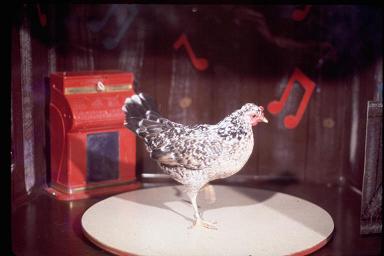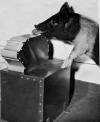|

|
Many of the exhibits at the IQ-Zoo and the
projects of ABE were based on a knowledge of evolutionary contingencies and
the careful observation of animals in their natural
habitats. Evolutionary contingences refer to the factors that have
shaped animal behavior over many generations, often over millions of years.
The behaviors that the animals were trained to perform at the IQ Zoo were
seldom new activities for them. For instance, chickens often scratch
for food. Under the right circumstances, the chicken’s scratching can
be made to look like dancing. Ducks dabble for food. When dabbling
over the strings of a guitar, the duck appears to be playing the
instrument. However, the dancing chicken and the dabbling duck are just
doing what comes naturally.
|
|


|
Instinctual drift is the tendency of some trained animals to
revert back to instinctual behaviors. In other words, they will behave in
accordance with evolutionary contingencies, as opposed to the operant
contingencies of their training. These behaviors are often unnecessary, and
seldom useful. The term “instinctual drift” was first used by Keller
and Marian Breland in their 1961 article, “The Misbehavior of Organisms,”
published in the journal American Psychologist. The article addressed some
deficiencies in B.F. Skinner’s book The
Behavior of Organisms (1938). In his book, Skinner described the
Skinner Box and the basics involved with operant conditioning. His work
seemed to assert that all animals started off on equal footing when it came
to operant conditioning (later, he denied that he ever implied this). However,
after working with a variety of species for 25 years, the Brelands reached
a different conclusion. One of the colorful examples of instinctual drift
occurred when the Brelands were training animals for the “Piggy Bank”
exhibit. The pigs were being trained to pick up large wooden nickels in
their mouths and deposit them into piggy banks. Depositing coins was
reinforced with food. However, some of the pigs would stop picking up
the coins and would instead “root” at them, shoving their snouts under the
coins and tossing them into the air, as though they were digging for food.
These animals had already been taught that all that they had to do to earn
food was drop the coins in the bank. However, they rooted at the coins
instead. Despite the fact that this behavior was completely
ineffective in getting the hungry pigs their food, the pigs reverted to it,
seemingly because it was what they instinctively did when they were
hungry. Another example of this tendency was seen with the
Capsule-Vending Chicken. The chicken was taught to pull a loop in order to
deliver a plastic capsule to the customer. After the chicken triggered the
delivery mechanism, a plastic capsule rolled down a slide and landed in
front of the chicken. The chicken was supposed to peck at the capsule,
causing it to fall off the slide and into the hands of the waiting
customer. However, some of the chickens reverted to instinctive behavior
and began pecking at the capsule as they would at a bean pod, with the
seeming intent to break them open. To open the capsules, they would bang
the capsules against hard surfaces, and often toss them into the air.
|